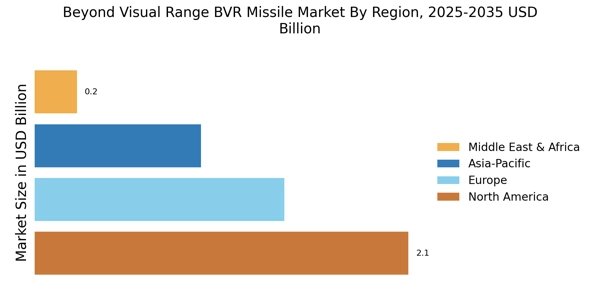Increased Defense Budgets
The Beyond Visual Range BVR Missile Market is significantly influenced by the rising defense budgets of various nations. Countries are prioritizing the enhancement of their military capabilities, particularly in air defense and strike capabilities. For instance, defense spending has seen a notable increase, with estimates suggesting a rise of over 5% in several regions. This trend is driven by geopolitical tensions and the need for advanced military technologies. As nations seek to bolster their aerial combat capabilities, investments in BVR missile systems are expected to grow. This increase in defense budgets not only supports the development of new missile technologies but also facilitates the procurement of existing systems, thereby propelling the market forward.
Strategic Alliances and Collaborations
The Beyond Visual Range BVR Missile Market is benefiting from strategic alliances and collaborations among defense contractors and governments. These partnerships facilitate the sharing of technology and resources, enabling the development of advanced missile systems. Collaborative efforts often lead to the creation of innovative solutions that enhance the capabilities of BVR missiles. For instance, joint ventures between nations can result in the co-development of missile systems tailored to specific operational requirements. Such collaborations not only expedite the development process but also expand market reach, as companies leverage each other's strengths. This trend is likely to continue, further driving growth in the BVR missile market.
Emerging Markets and Defense Modernization
The Beyond Visual Range BVR Missile Market is witnessing growth in emerging markets as countries modernize their defense forces. Nations in Asia-Pacific and the Middle East are increasingly investing in advanced military technologies, including BVR missile systems. This modernization is often driven by the need to counter regional threats and enhance national security. Reports indicate that defense spending in these regions is projected to grow at a compound annual growth rate (CAGR) of over 6% in the coming years. As these countries seek to establish a more formidable military presence, the demand for BVR missiles is likely to increase, presenting opportunities for manufacturers and suppliers in the industry.
Geopolitical Tensions and Regional Conflicts
The Beyond Visual Range BVR Missile Market is heavily impacted by ongoing geopolitical tensions and regional conflicts. Nations are increasingly aware of the need for advanced military capabilities to deter potential threats. The rise in territorial disputes and military confrontations has led to a heightened focus on air superiority, prompting countries to invest in BVR missile systems. For example, regions experiencing heightened military activity are likely to see a surge in demand for these advanced missiles. This focus on maintaining a strategic edge in aerial combat is expected to drive the market, as countries prioritize the acquisition of BVR missiles to enhance their defense postures.
Technological Advancements in Missile Systems
The Beyond Visual Range BVR Missile Market is experiencing a surge in technological advancements, particularly in missile guidance systems and propulsion technologies. Innovations such as active electronically scanned array (AESA) radars and advanced seeker technologies enhance the accuracy and effectiveness of BVR missiles. These advancements not only improve target acquisition but also increase the operational range of missiles, making them more effective in combat scenarios. The integration of artificial intelligence and machine learning into missile systems is also gaining traction, potentially revolutionizing the way BVR missiles are deployed and managed. As nations invest in modernizing their military capabilities, the demand for advanced BVR missile systems is likely to rise, indicating a robust growth trajectory for the industry.


















Leave a Comment